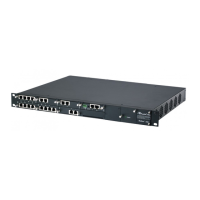Version 6.4 157 March 2012
SIP User's Manual 12. Media
12.3.4 Configuring RTP Multiplexing (ThroughPacket)
The device's RTP Multiplexing (ThroughPacket™) feature is AudioCodes proprietary
method for aggregating RTP streams from several channels when the device operates with
another AudioCodes device. This feature reduces the bandwidth overhead caused by the
attached Ethernet, IP, UDP, and RTP headers and reduces the packet/data transmission
rate. It reduces the load on network routers and can typically save up to 50% (e.g., for
G.723) on IP bandwidth. RTP multiplexing is accomplished by aggregating payloads from
several channels into a single IP packet, which are sent to the same destination IP
address. You can enable RTP multiplexing for all destinations (as described in the
procedure below) or for a specific IP destination using IP Profiles (see 'Configuring IP
Profiles' on page 219).
Notes:
• RTP Multiplexing must be enabled on both devices.
• When VLANs are implemented, the RTP Multiplexing mechanism is not
supported.
• When RTP Multiplexing is used, call statistics are unavailable (as there is
no RTCP flow).
The procedure below describes how to configure RTP multiplexing using the Web
interface.
To configure RTP multiplexing parameters:
1. Open the RTP/RTCP Settings page (Configuration tab > VoIP menu > Media
submenu > RTP/RTCP Settings). The RTP Multiplexing parameters are shown
below:
Figure 12-3: RTP Multiplexing Parameters in RTP/RTCP Settings Page
2. Enable RTP Multiplexing by setting the 'Remote RTP Base UDP Port' field
(RemoteBaseUDPPort) to a non-zero value. This port must be the same as the port
set by the 'RTP Base UDP Port' field (BaseUDPPort) parameter at the remote device.
Conversely, when configuring the remote device, its 'Remote RTP Base UDP Port'
field value must be the same as this local device's 'RTP Base UDP Port' field value.
These parameters identify and distribute the payloads from the received multiplexed
IP packet to the relevant channels.
3. Set the local UDP port for outgoing multiplexed RTP packets, using the 'RTP
Multiplexing Local UDP Port' field (L1L1ComplexTxUDPPort).
4. Set the destination UDP port for outgoing multiplexed packets, using the 'RTP
Multiplexing Remote UDP Port' field (L1L1ComplexRxUDPPort). This also configures
the local UDP port for incoming multiplexed RTP packets.
5. Click Submit, and then save your settings to flash memory with a device reset.

